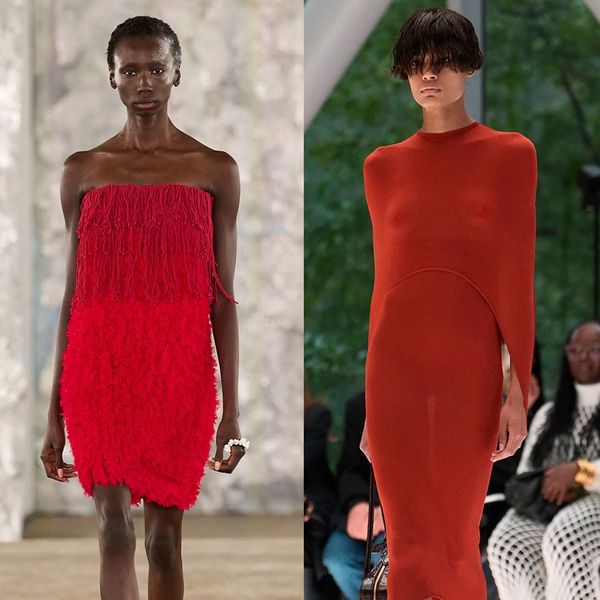Younger Generations May Be Flirting with Christianity
From Lana Del Rey’s “Judah Smith Interlude” to the resurgence of “Hot Girl Catholicism,” is religion trending, or are younger generations really turning to God?

“It’s her best album so far. I can’t stop listening to it,” my friends raved upon the release of Lana Del Rey’s newest oeuvre Did You Know There’s a Tunnel Under Ocean Blvd—an album as verbose and meandering as its title would suggest. I fall under the laziest category of Lana fan; I am not a die-hard fanatic, but I find her pouty self-mythologizing and psychosexual devotion to America to be amusing. I find myself replaying her albums more than I’d like to admit, and my Spotify Wrapped likes to slap me with that reality check once a year. Whether there’s an element of irony in her persona, we’ll never know for sure, but one thing is certain—she is committed to the bit.
When the new album came out, I cued it up for a drive across LA. The unmistakable Christian timbre of the opening lines of “The Grants” was not what I expected, but as the fourth track “A&W” busted out with the folk-trap chorus “jimmy jimmy cocoa puff,” I was assured we were back to the “horny sad” anthems we’ve come to expect. Almost as if to punish me for lip-synching “American Whore” for seven minutes, the following track—“Judah Smith Interlude”— began with a sermon. A man shouts a fiery condemnation of lust with the fanfare of an evangelical preacher. I thought, “Ok, interesting intro”—I sat there, foolishly waiting for a song to take shape, but no. There I was, the spitting image of my own unironically Christian mother, accidentally listening to a full-blown sermon in my Impreza. I knew Lana liked to fetishize Americana, but has she really gone from “my pussy tastes like Pepsi cola” to megachurch sermons? For a fanbase of horny, depressed women and gay men, the full-track sermon had me flummoxed.
While the “Judah Smith Interlude” is easily dismissed as a “skip” on the album, my subsequent Internet-sleuthing left me with far more questions than answers. Judah Smith’s brushes with homophobia raised appropriate concern amongst her listeners. Lana’s die-hard fans analyzed the track with say-it-ain’t-so scrutiny and convinced themselves that her occasional giggles during the recording were a snide condemnation of the pastor’s words. With the other Christian overtones in the album and her penchant for problematic themes, I found myself doubting she would give so much airtime to this particular brand of subtle irony. Lana rarely opts for subtlety.
For context, Judah Smith is a pastor at a Hollywood-based megachurch called Churchome. After the rise and fall of celebrity megachurch Hillsong, it appears this is the place where Christian celebs like Justin Bieber, Selena Gomez, Kourtney Kardashian, and more fled to for their occasional worship. Judah Smith looks like Christian Slater in skinny jeans, and his brand of non-denominational Christianity gives Churchome an unmistakable “our God is an awesome God” energy. It only makes sense that ex-Disney stars and culturally beige celebs like Hailey Bieber would flock to this type of influencer pastor. Without ties to any historical brand of Christianity, it’s a safe option—the same type of vague, American spiritualism of thanking “God and my manager” in one breath at an awards ceremony.
Lana’s work has always idolized the perversions of American culture—consumerism, Hollywood, sex, innocence lost and found—now she seems to be holding a mirror to America’s first wife: Christianity. If you asked me to anticipate Lana’s religious phase a year ago, I would have predicted “hot-girl Catholicism” (I will explain that further later), but I’m realizing megachurch is actually far closer aligned with her brand. About 63 percent of America is Christian, and nearly a quarter of that is evangelical. While not all megachurches are evangelical, they certainly make up the majority. Yes, evangelicals are an incredibly vocal component of America's conservative party but—while enmeshed with politics—this isn’t the focus of this argument. In contrast, I’ve really only taken notice of this cultural flirtation with Christianity because it’s being adopted, or at least consumed, by liberals. There’s no Gallup poll of Lana stans, but I would say the majority of her fanbase is liberal and progressive. So are we liberals really clutching our pearls about this megachurch sermon? After all, she’s always had a penchant for American flags, guns, and problematic opinions, but she’s just being Lana, right? It’s all part of the bit - but has this really all been a bit?
Lana aside, liberals seem to have a renewed fascination with Christian culture. This is due, in part, to a resurgence of a phenomenon I like to call “Hot Girl Catholicism.” Remember the “Father Son Holy Spirit” bikini from Praying that went viral in 2021? With other merch sporting words like “God’s Favorite” and “Trophy Wife,” I thought this was all pointing towards the same deadpan irony of most Internet trends. Whether it’s “cool-girl-gone-quasi-Catholic” or the “cottagecore” TikTok trend, there has always been the boomerang effect of where seemingly “trad” becomes “alt.” The world of fashion is no stranger to Catholic imagery. Well-summarized in the 2018 MET exhibition “Heavenly Bodies: Fashion and the Catholic Imagination,” the opulence and pageantry of Catholicism have seduced many designers over the years. This is far from new; in fact, it’s a cyclical fashion trend—from Madonna’s “Like A Virgin” era in the 80s to Sarah Michelle Geller’s coke-spoon crucifix in Cruel Intentions circa 1999—hot girls and catholicism have always been a match made in irony-steeped heaven. What’s different about this particular resurgence in “hot girl catholicism?” I can’t tell if it’s ironic anymore.
Every disaffected, progressive leftist, Wellbutrin girlie worth their salt considers Dasha Nekrasova a household name. Dubbed “sailor socialism” after a 2018 interview with an InfoWars reporter went viral, the actor/filmmaker became a leftist “it girl” and co-host of the podcast Red Scare. The podcast is a bat signal for the “dirtbag left”—embracing vulgarity and edgelord humor to eschew Neo-liberal centrism—and is associated with the subculture surrounding lower Manhattan’s Dimes Square. For context, Dimes Square is like the “cool kids” lunch table in the Manhattan cafeteria. Why am I bringing up Dasha? This New York Mag “it girl” has recently reverted to Catholicism—unironically, she claims. With the political climate surrounding abortion and LGBTQ rights, it’s an unexpected choice for the podcaster, but it reflects a larger shift. The New York Times has written several pieces in the last two years about the “Dimes Square Catholicism”. On a more concerning note, according to recent articles, the Red Scare’s socialism has now mutated into ideologies of the New Right. The question remains—is it all for shock value? Is this simply an edgelord transgression? Is it a “life as art” photocopy of Warhol’s own inscrutable relationship with Catholicism? In a TikTok, Nekrasova says she is still navigating her own relationship with Catholicism, saying, “David Foster Wallace talks about this in reference to AA, that it doesn’t really matter if you’re doing something ironically because it still works. It seems insane to go to mass ‘ironically,’ but if you go to mass, even if you don’t ‘mean it,’ things will happen to you regardless.”
@jmrphy Dasha Nekrasova on the Other Life Podcast. Full ep on Youtube #catholicism #dashanekrasova #redscare #fyp #otherlife ♬ original sound - Justin Murphy
@jmrphy Dasha Nekrasova on the Other Life podcast #otherlife #podcast #dashanekrasova #redscare #fyp ♬ original sound - Justin Murphy
Whether Lana or Dasha are finding their faith un-ironically or simply “committing to the bit,” as artists are wont to do, younger generations seem to be embracing faith with a new frequency. An article in the Wall Street Journal states that “about one-third of 18 to 25-year-olds say they believe—more than doubt—the existence of a higher power, up from about one-quarter in 2021.” This is a surprising trend considering the well-documented statistics that each new generation is less religious than the last. Through surveys and anecdotes, some have come to the conclusion that, while not connected to a specific religious doctrine, there is a greater desire in younger generations to connect to a higher power. Why? Many are citing destabilizing aspects of the Covid-19 pandemic to be the root cause of this resurgence in faith. In fact, “47% more young people are attending church since the pandemic.” Especially for Gen-Z, this is the first major trauma experienced in their lives and—much like generations returning to the church following the devastation of WWII—we are all grasping for some semblance of meaning and order.
This may also be the natural swing of the pendulum as our youngest generation was raised by predominantly nonreligious parents. As fewer young people were raised with the trappings and trauma of a religious upbringing, spirituality has renewed intrigue. We’re living in a time where astrology, crystals, and “manifesting” have all gone mainstream. When I was younger, liberal parents in San Francisco pooh-poohed the spiritual. Atheism was hot. Anything that wasn’t rooted in scientific fact was dismissed as ignorance. Now, twenty years later, this dismissive attitude and adherence to “proof” feels reductive and old-fashioned. Yes, we all believe in science but this generation embraces mysticism and post-modern ambiguity with a softer eye.
Raised with the Internet, younger generations can parse through information with unprecedented alacrity. They consume and dispose of trends with less preciousness than any generation before. There is a “take what you like and leave the rest” attitude when it comes to ideology. As Dasha said, “it doesn’t really matter if you’re doing something ironically because it still works.” While there was a purity in the strict categories of one’s identity for Gen X and elder millennials—you’re a punk, jock, square, etc.—younger generations skew towards pastiche. A little bit ironic, a little bit sincere—it doesn’t matter to them as much.
Yes, “Catholicism is a trend” certainly makes for splashier headlines, as does “Lana Del Rey promotes a homophobic pastor.” It’s buzzy, it’s provocative, and it’s sure to drive up engagement in the comment section. But the truth may be both more complicated and less interesting. Some people are resonating with themes of Catholicism. Lana Del Rey may find aspects of a sermon compelling. Not everything is an endorsement of an institution in its totality. I think the only “trend” I’m seeing among younger generations is a weariness in expecting any one institution, party, or ethos to reflect all their personal beliefs. Why must curiosity be followed with commitment? As long as it isn’t hurting anyone, can we flirt with certain ideas and dispose of them as we please? Is this non-monogamous approach to meaning a trend or a mature dismissal of certainty? Maybe, in the end, the answer is that the “bit” doesn’t require as much commitment as we once expected.
Want more stories like this?
Has Toxic Self-Care Sparked an Empathy Crisis?
Is Marital Hate Really "Normal"?
Is Monogamy So Out It's Kinky?




